As Professor Theo Barker introduces in his Three Hundred Years of Red Lion Square: 1684-1984, “The laying out of Red Lion Square in June 1684 was marked by scenes of violent protest which obligingly enable us to date the event with some precision”. Barker also includes William Morgan’s map of 1682, which immediately predates the eventual construction and shows “all the land to the north of a thin ribbon of buildings skirting High Holborn.”
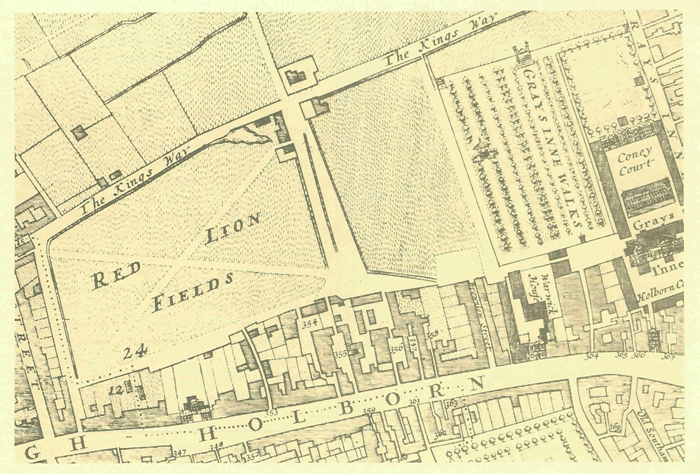
Red Lion Fields named after the original Red Lyon Inn and Red Lion Street, both off High Holborn.
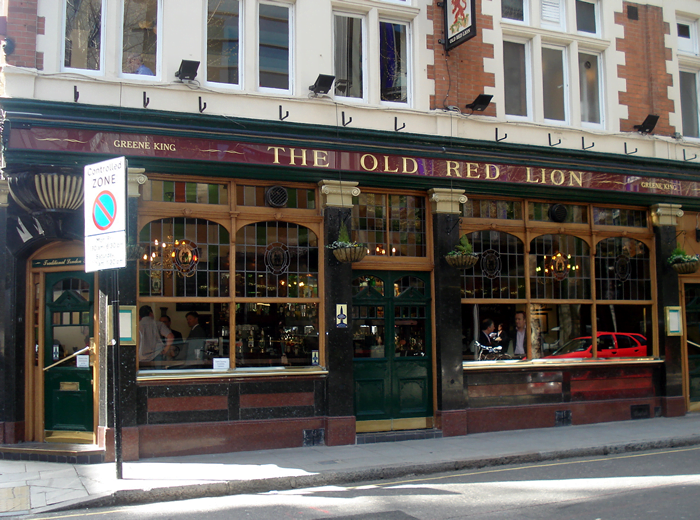
The Red Lyon Inn, established in the Sixteenth Century (rebuilt in 1899), was reputed to be the most important hostelry in Holborn. Barker notes, “In better weather patrons engaged in energetic, thirst-making sports in Red Lion Fields or just took their drinks outside. The lawyers and their students at nearby Gray’ s Inn were also in the habit of seeking their recreation in this open space to the west of them.”
But the story of the Square really begins, it is rumoured, 23 years earlier. In 1661, Charles II ordered the bodies of the three signatories of his father’s death warrant, who had died natural deaths to be exhumed and tried at Newgate. These were Oliver Cromwell, Henry Ireton, an English general in the army of Parliament during the English Civil War, and John Bradshaw, one of the judges who sentenced Charles I to death. Still in their shrouds, the bodies were drawn on sledges to trial, condemned, and then dragged to the Red Lyon Inn: hence to Tyburn, where they were to be beheaded. However, many believe that that their bodies never made it to Tyburn. Instead, the poet John Milton, with Dr Nicholas Barbon and Ebenezer Heathcote, were rumoured to have been involved in a plot to bribe the guards of the bodies at The Red Lyon Inn, substituting alternative corpses and then burying the Parliamentarians in Red Lion Fields with an rough and plain obelisk to mark the spot.
In 1684, Nicholas Barbon returns to ignite Red Lion’s Square’s history. This time, he is the cause of a battle his between builders and the lawyers.
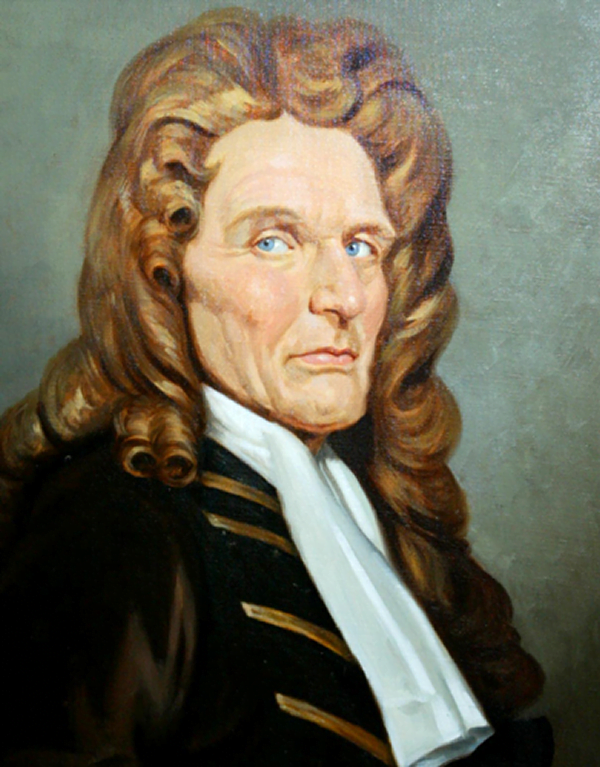
He was the eldest son of Praise-God Barbon, author of Barebone’s Parliament, the last attempt of the English Commonwealth to find a stable political form before the installation of Oliver Cromwell as Lord Protector, Nicholas trained as a physician and received his doctorate when studying in Utrecht in 1661. Three years later he became an honorary fellow of the Royal College of Physicians, in London. Medicine, however, was not to be his real vocation. Property development was the arena within which he made his mark upon history, with Barker stating that Barbon was “the most successful building speculator of his day.”
Following the Great Fire of London in 1666 and Sir Christopher Wren’s enthusiasm for redesigning, Barbon helped to shape The Strand and Bloomsbury and to connect the City with Westminster courtesy of swathes of housing and commercial developments. In 1684, though, Red Lion Fields came once more, if one believes the Cromwell tale, across his path. Barker describes Barbon’s flair for dividing up sites into “prestigious houses” set around “an airy central square”, with “more modest properties” densely packed on further perimeters to act as “screens” from the hustle and bustle of the “meaner dwellings beyond”.
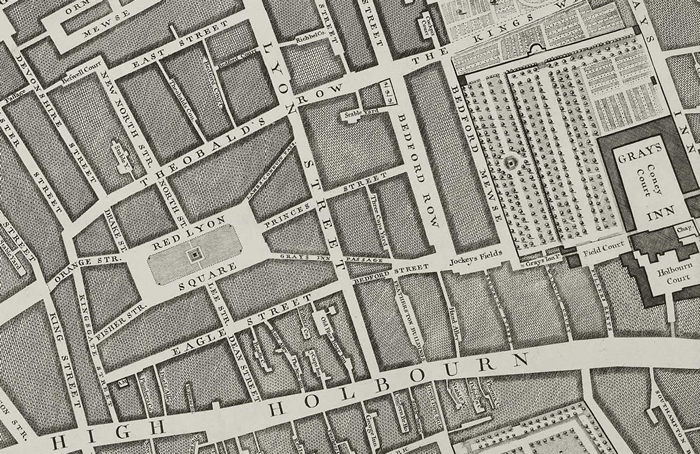
His model set, Barbon could begin dividing up Red Lion Fields to create a new square with greater exclusiveness and commercial return. As far as he was concerned, he needed to screen off the south side from High Holborn’s noisy traffic of animals bound for slaughter in the City, and disregard various Acts of Parliament and Royal Declarations that might have prevented a less determined developer from demolishing existing buildings and rebuilding as he saw fit. Unfortunately, for Barbon, one hundred or so lawyers from Gray’s Inn physically stood in his way.
After losing their case in court, Barbon having purchased the land legally, the lawyers took to the field. Their resulting loss of “wholesome air” they deemed worth fighting for and fight they did. On the 11th June 1684 a pitched battle broke out between the workmen and lawyers armed with bricks and other sundry building materials. Both sides sustained injuries, but with Barbon himself leading the workmen they won and building continued. The first leases in Red Lion Square were granted in 1686 and, ironically, some of the early tenants were lawyers from Gray’s Inn!
Barker records that the “new square seems to have been highly successful in attracting to it men of quality as Barbon had intended”. As well as lawyers, doctors and other professionals turned to Barbon’s development to provide for their residential needs. The renowned surveyor Edward Hatton, in 1708, described the Square as “a pleasant square of good buildings, between High Holborn south and the fields north”. Another observer, writing in 1720, Barker discovered, “remarked favourably upon the rows of trees, gravel walks and grass plots in the square”, stating that they were “all neatly kept for the inhabitants to walk in.” By 1729, the rate book for the area showed that among the forty houses in the square, numbered anti-clockwise from the north-west corner, there were six knights and two titled ladies. One of the knights, Sir Robert Raymond, Barker notes, became Lord Chief Justice and died at number 23 on the east side.
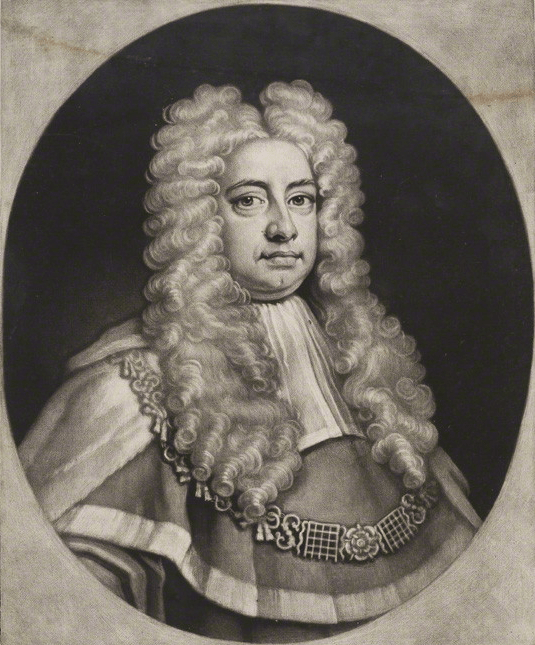
A period of change seemed to creep threateningly in the 1730s. In a much quoted volume, A Tour through Great Britain, an unknown author states as follows: “This present year, 1737, an Act was passed for beautifying Red Lyon Square, which had run much to decay”. The Act of Parliament, Barker explains, passed a levy “upon all the residents in order to have the Square’s appearance improved”. He identified that the Square had become “a receptacle for rubbish, dirt and nastiness of all kinds and an encouragement to common beggars, vagabonds and other disorderly persons to resort thither for the exercise of their idle diversions and other unwarrantable purposes”. Barker concludes that around this time, or soon afterwards, “new railings were put up round the square and rather forbidding watch-houses put up at each corner.”
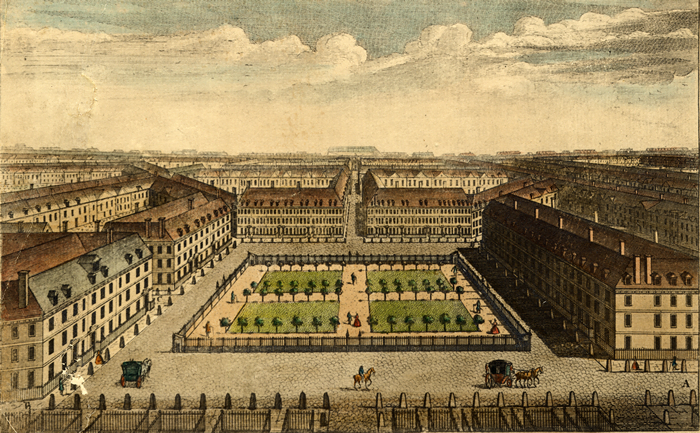
Interesting piece – but in what alternate universe would the Red Lyon Inn have been a stop on any reasonable route between Westminster Abbey and Tyburn?
Dear Mark, I agree. I had to look on a map to check the route and it didn’t appear to make sense. However, history, if we believe at least the part where the guards bought the bodies to Red Lion Inn, tells the tale told. 🙂
Did a bit of reading; it seems that if ancient tradition was followed, the exhumed bodies would have been taken to Newgate Prison, and drawn by hurdle or sledge from there to the King’s Gallows at Tyburn. The route would have followed today’s High Holborn, New Oxford Street, an Oxford Street, then the Tyburn Road. One can imagine that if the disinterrment and transportation to Newgate took much of a day, and the bodies were sent onward immediately, an overnight stop at the Old Red Lion would not be unlikely.